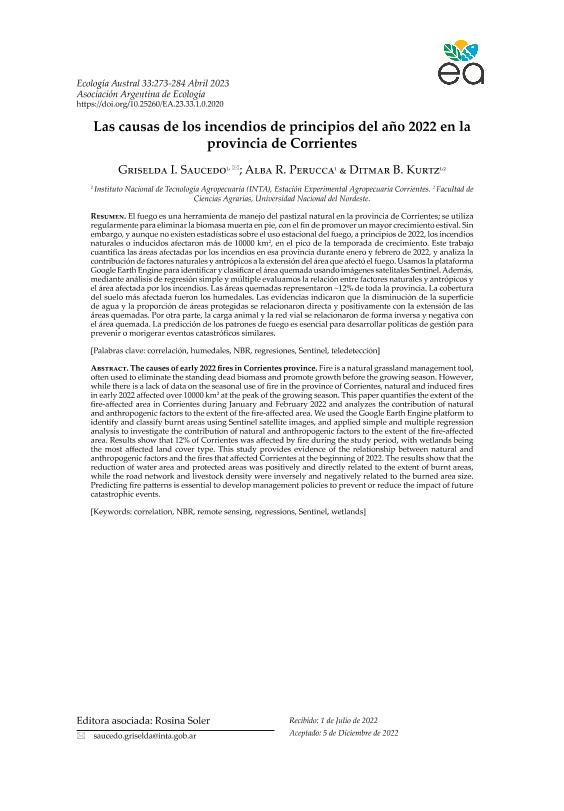Mostrar el registro sencillo del ítem
dc.contributor.author
Saucedo, Griselda Isabel

dc.contributor.author
Perucca, Alba R.
dc.contributor.author
Kurtz, Ditmar Bernardo

dc.date.available
2024-01-09T13:03:26Z
dc.date.issued
2023-03
dc.identifier.citation
Saucedo, Griselda Isabel; Perucca, Alba R.; Kurtz, Ditmar Bernardo; Las causas de los incendios de principios del año 2022 en la provincia de Corrientes; Asociación Argentina de Ecología; Ecología Austral; 33; 1; 3-2023; 273-284
dc.identifier.issn
0327-5477
dc.identifier.uri
http://hdl.handle.net/11336/222994
dc.description.abstract
El fuego es una herramienta de manejo del pastizal natural en la provincia de Corrientes; se utiliza regularmente para eliminar la biomasa muerta en pie, con el fin de promover un mayor crecimiento estival. Sin embargo, y aunque no existen estadísticas sobre el uso estacional del fuego, a principios de 2022, los incendios naturales o inducidos afectaron más de 10000 km2, en el pico de la temporada de crecimiento. Este trabajo cuantifica las áreas afectadas por los incendios en esa provincia durante enero y febrero de 2022, y analiza la contribución de factores naturales y antrópicos a la extensión del área que afectó el fuego. Usamos la plataforma Google Earth Engine para identificar y clasificar el área quemada usando imágenes satelitales Sentinel. Además, mediante análisis de regresión simple y múltiple evaluamos la relación entre factores naturales y antrópicos y el área afectada por los incendios. Las áreas quemadas representaron ~12% de toda la provincia. La cobertura del suelo más afectada fueron los humedales. Las evidencias indicaron que la disminución de la superficie de agua y la proporción de áreas protegidas se relacionaron directa y positivamente con la extensión de las áreas quemadas. Por otra parte, la carga animal y la red vial se relacionaron de forma inversa y negativa con el área quemada. La predicción de los patrones de fuego es esencial para desarrollar políticas de gestión para prevenir o morigerar eventos catastróficos similares.
dc.description.abstract
Fire is a natural grassland management tool, often used to eliminate the standing dead biomass and promote growth before the growing season. However, while there is a lack of data on the seasonal use of fire in the province of Corrientes, natural and induced fires in early 2022 affected over 10000 km2 at the peak of the growing season. This paper quantifies the extent of the fire-affected area in Corrientes during January and February 2022 and analyzes the contribution of natural and anthropogenic factors to the extent of the fire-affected area. We used the Google Earth Engine platform to identify and classify burnt areas using Sentinel satellite images, and applied simple and multiple regression analysis to investigate the contribution of natural and anthropogenic factors to the extent of the fire-affected area. Results show that 12% of Corrientes was affected by fire during the study period, with wetlands being the most affected land cover type. This study provides evidence of the relationship between natural and anthropogenic factors and the fires that affected Corrientes at the beginning of 2022. The results show that the reduction of water area and protected areas was positively and directly related to the extent of burnt areas, while the road network and livestock density were inversely and negatively related to the burned area size. Predicting fire patterns is essential to develop management policies to prevent or reduce the impact of future catastrophic events.
dc.format
application/pdf
dc.language.iso
spa
dc.publisher
Asociación Argentina de Ecología

dc.rights
info:eu-repo/semantics/openAccess
dc.rights.uri
https://creativecommons.org/licenses/by/2.5/ar/
dc.subject
Correlación
dc.subject
Humedales
dc.subject
Regresiones
dc.subject
Sentinel
dc.subject.classification
Otras Ciencias de la Tierra y relacionadas con el Medio Ambiente

dc.subject.classification
Ciencias de la Tierra y relacionadas con el Medio Ambiente

dc.subject.classification
CIENCIAS NATURALES Y EXACTAS

dc.title
Las causas de los incendios de principios del año 2022 en la provincia de Corrientes
dc.title
The causes of early 2022 fires in Corrientes province
dc.type
info:eu-repo/semantics/article
dc.type
info:ar-repo/semantics/artículo
dc.type
info:eu-repo/semantics/publishedVersion
dc.date.updated
2024-01-08T14:15:52Z
dc.journal.volume
33
dc.journal.number
1
dc.journal.pagination
273-284
dc.journal.pais
Argentina

dc.journal.ciudad
Buenos Aires
dc.description.fil
Fil: Saucedo, Griselda Isabel. Instituto Nacional de Tecnología Agropecuaria. Centro Regional Corrientes. Estación Experimental Agropecuaria Corrientes; Argentina. Consejo Nacional de Investigaciones Científicas y Técnicas. Centro Científico Tecnológico Conicet - Nordeste; Argentina
dc.description.fil
Fil: Perucca, Alba R.. Instituto Nacional de Tecnología Agropecuaria. Centro Regional Corrientes. Estación Experimental Agropecuaria Corrientes; Argentina
dc.description.fil
Fil: Kurtz, Ditmar Bernardo. Instituto Nacional de Tecnología Agropecuaria. Centro Regional Corrientes. Estación Experimental Agropecuaria Corrientes; Argentina
dc.journal.title
Ecología Austral

dc.relation.alternativeid
info:eu-repo/semantics/altIdentifier/doi/https://doi.org/10.25260/EA.23.33.1.0.2020
dc.relation.alternativeid
info:eu-repo/semantics/altIdentifier/url/https://ojs.ecologiaaustral.com.ar/index.php/Ecologia_Austral/article/view/2020
Archivos asociados
